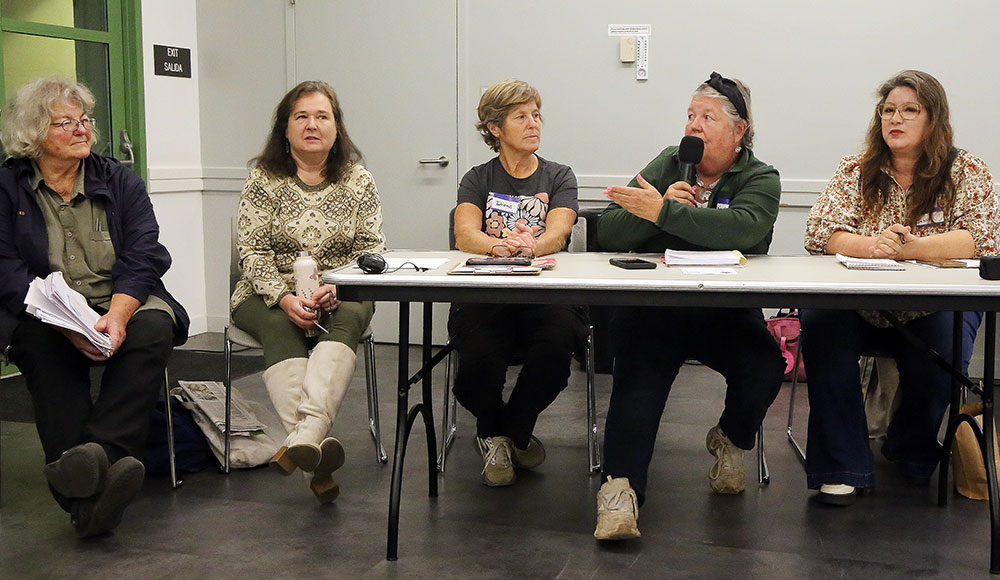Almost a year after the largest lithium-ion battery storage facility in the world caught fire at Moss Landing, spewing toxic material and forcing the evacuation of 1,200 people, Santa Cruz residents gathered to warn against a proposal to build three more of the facilities in the county.
Firefighters had no way to put out the Jan. 16 blaze and had to wait for it to go out on its own, which it did two days later. But then it reignited for a day in February, and officials say it will take a year to clean up the site.
Some 50 people joined a meeting held by a local group called Stop Lithium Battery Energy Storage Systems (BESS) In Our Neighborhoods Monday at the Simpkins Family Swim Center in response to proposals to build three storage plants near homes, schools and a hospital.
“We advocate for safe, non-lithium battery technology, transparency, and our community’s voice in the decision-making process,” the group’s website says. “By raising awareness, educating the public and advocating for safe community environments, we work to prevent the development of hazardous lithium BESS facilities near homes, schools, hospitals, congregate care facilities, farms and natural habitats.”
The state government has been pushing for more battery storage units in an effort to wean off carbon fuels for electricity generation. The batteries store energy from solar and wind and the state’s department of energy has plans to build many more. From 2018 through mid-2025, battery storage capacity in California increased from 500 megawatts to more than 16,900 MW, according to a report by the California Energy Commission. The state projects 52,000 MW of battery storage will be needed by 2045.
There is debate over who should approve and regulate the units: the state or local governments.
Nina Audino, co-founder the group, told the meeting that in order to get a permit to operate a better facility, it is better to have local control, through county planning, than it is to go to the state control of battery facilities.
“Local control only works better for the community if the control is centered in a rigorous ordinance that protects us,” Audino said. “If there isn’t such an ordinance, then essentially local control means that the developer gets to do what they want to do. It’s the job of the county to create a really tough ordinance. … In our case, as part of our local control the county is stating the developer’s consultant will write and pay for an environmental review, which is typically the case.”
Audino stressed that the county must step in with a “tough ordinance.”
Panel member Karell Reader said her research into battery storage was triggered by the Jan. 16 fire, the hazardous toxic fallout and a thermal runaway at the edge of the Monterey Bay Sanctuary.
“We are in a place where we need to store the electricity that we are producing with solar and onshore wind,” she said, “and we need to find a way to keep this energy in our grid so we will not have blackouts and brownouts.” But as her research deepened, she said, she learned that “lithium was the problem.”
“There is no way to have a lithium battery storage facility without danger…they are not stable,” Reader said. She then spoke of “new batteries” now being used that are unlike the Moss Landing batteries that caught fire, that use a “slightly different chemistry” and that advocates for them “say they won’t burn, and won’t explode.”
“But they do,” she said. “That is completely made up.”
Much of the meeting focused on a proposed BESS system at 90 Minto Road in Watsonville, a neighborhood surrounded by homes and farmland near College Lake.
“We have to look really hard at why lithium is the problem and that there are better alternatives that are hard to fund but they are doable. We just want our county to think a little bit more broadly and maybe give some of those new technologies a chance.”
Audino pointed out how BESS planners are seeking rural areas everywhere “not just in America but all over the world; they’re choosing farmland areas that are wide open, and that is not okay.”
The panel played two videos of fire officials speaking strongly about the daunting tasks of trying to quell fires at battery facilities and the hazards that loom over surrounding neighborhoods.
Reader said that the electricity stored in BESS will not necessarily be used locally.
“It will go to the highest bidder,” she said. “Little Watsonville, Pajaro, Santa Cruz—Gilroy even—they’re not going to be the highest bidder for the industry that we store for them…the highest bidder will be Santa Clara or Woodside or maybe Sacramento. But we are being asked to risk and bear a burden in our community for which we currently have no real lower energy costs or less chances of brownouts or blackouts. I don’t think that’s fair.”
She said she believes “we are doing this for big AI data storage.”
The panel also addressed the lifespan of lithium batteries, safe transport of expired batteries to a receiving landfill in Nevada, misleading claims of safety and common failures.
Santa Cruz County officials on Nov. 6 released a preliminary set of rules that would govern new BESS facilities. The board will discuss the draft plan on Nov. 18. It can be accessed at bit.ly/4orihVV











